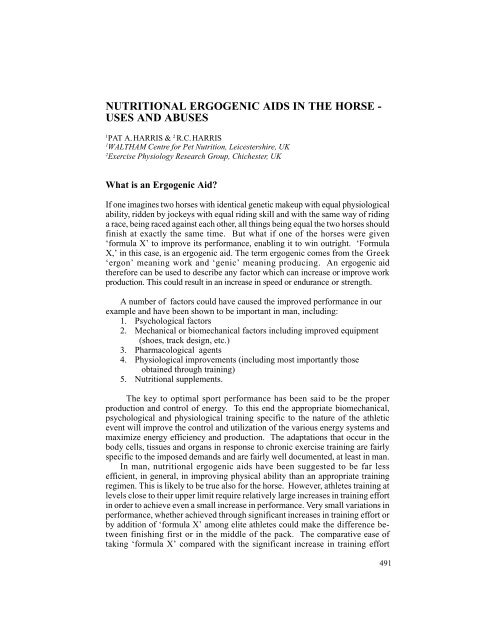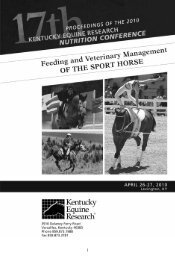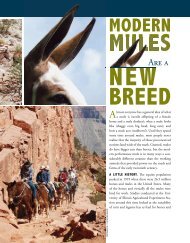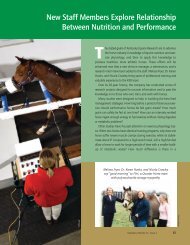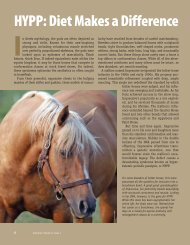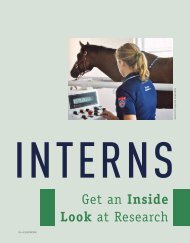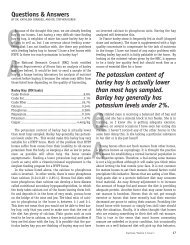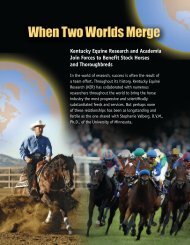Nutritional Ergogenic Aids in the Horse - Kentucky Equine Research
Nutritional Ergogenic Aids in the Horse - Kentucky Equine Research
Nutritional Ergogenic Aids in the Horse - Kentucky Equine Research
- No tags were found...
Create successful ePaper yourself
Turn your PDF publications into a flip-book with our unique Google optimized e-Paper software.
P.A. Harris and R.C. Harris491NUTRITIONAL ERGOGENIC AIDS IN THE HORSE -USES AND ABUSES1PAT A. HARRIS & 2 R.C. HARRIS1WALTHAM Centre for Pet Nutrition, Leicestershire, UK2Exercise Physiology <strong>Research</strong> Group, Chichester, UKWhat is an <strong>Ergogenic</strong> Aid?If one imag<strong>in</strong>es two horses with identical genetic makeup with equal physiologicalability, ridden by jockeys with equal rid<strong>in</strong>g skill and with <strong>the</strong> same way of rid<strong>in</strong>ga race, be<strong>in</strong>g raced aga<strong>in</strong>st each o<strong>the</strong>r, all th<strong>in</strong>gs be<strong>in</strong>g equal <strong>the</strong> two horses shouldf<strong>in</strong>ish at exactly <strong>the</strong> same time. But what if one of <strong>the</strong> horses were given‘formula X’ to improve its performance, enabl<strong>in</strong>g it to w<strong>in</strong> outright. ‘FormulaX,’ <strong>in</strong> this case, is an ergogenic aid. The term ergogenic comes from <strong>the</strong> Greek‘ergon’ mean<strong>in</strong>g work and ‘genic’ mean<strong>in</strong>g produc<strong>in</strong>g. An ergogenic aid<strong>the</strong>refore can be used to describe any factor which can <strong>in</strong>crease or improve workproduction. This could result <strong>in</strong> an <strong>in</strong>crease <strong>in</strong> speed or endurance or strength.A number of factors could have caused <strong>the</strong> improved performance <strong>in</strong> ourexample and have been shown to be important <strong>in</strong> man, <strong>in</strong>clud<strong>in</strong>g:1. Psychological factors2. Mechanical or biomechanical factors <strong>in</strong>clud<strong>in</strong>g improved equipment(shoes, track design, etc.)3. Pharmacological agents4. Physiological improvements (<strong>in</strong>clud<strong>in</strong>g most importantly thoseobta<strong>in</strong>ed through tra<strong>in</strong><strong>in</strong>g)5. <strong>Nutritional</strong> supplements.The key to optimal sport performance has been said to be <strong>the</strong> properproduction and control of energy. To this end <strong>the</strong> appropriate biomechanical,psychological and physiological tra<strong>in</strong><strong>in</strong>g specific to <strong>the</strong> nature of <strong>the</strong> athleticevent will improve <strong>the</strong> control and utilization of <strong>the</strong> various energy systems andmaximize energy efficiency and production. The adaptations that occur <strong>in</strong> <strong>the</strong>body cells, tissues and organs <strong>in</strong> response to chronic exercise tra<strong>in</strong><strong>in</strong>g are fairlyspecific to <strong>the</strong> imposed demands and are fairly well documented, at least <strong>in</strong> man.In man, nutritional ergogenic aids have been suggested to be far lessefficient, <strong>in</strong> general, <strong>in</strong> improv<strong>in</strong>g physical ability than an appropriate tra<strong>in</strong><strong>in</strong>gregimen. This is likely to be true also for <strong>the</strong> horse. However, athletes tra<strong>in</strong><strong>in</strong>g atlevels close to <strong>the</strong>ir upper limit require relatively large <strong>in</strong>creases <strong>in</strong> tra<strong>in</strong><strong>in</strong>g effort<strong>in</strong> order to achieve even a small <strong>in</strong>crease <strong>in</strong> performance. Very small variations <strong>in</strong>performance, whe<strong>the</strong>r achieved through significant <strong>in</strong>creases <strong>in</strong> tra<strong>in</strong><strong>in</strong>g effort orby addition of ‘formula X’ among elite athletes could make <strong>the</strong> difference betweenf<strong>in</strong>ish<strong>in</strong>g first or <strong>in</strong> <strong>the</strong> middle of <strong>the</strong> pack. The comparative ease oftak<strong>in</strong>g ‘formula X’ compared with <strong>the</strong> significant <strong>in</strong>crease <strong>in</strong> tra<strong>in</strong><strong>in</strong>g effort491
492 <strong>Nutritional</strong> <strong>Ergogenic</strong> <strong>Aids</strong> <strong>in</strong> <strong>the</strong> <strong>Horse</strong>required expla<strong>in</strong>s why <strong>the</strong>re has been such a drive for effective nutritionalergogenic aids.Possible ways that ergogenic aids, apart from equipment, etc., could improveperformance <strong>in</strong> <strong>the</strong> horse could <strong>in</strong>clude (see also Harris, 1994):1. Psychological effects2. Improved coord<strong>in</strong>ation or recruitment of muscle fibers3. Provision of a supplementary fuel source or <strong>the</strong> feed<strong>in</strong>g of a feed witha higher energy content4. Increased levels of available stored energy5. Improved efficiency of conversion of <strong>the</strong> chemical energy of <strong>the</strong> feed,or stored energy, to mechanical energy for work6. Improved ATP/ADP homeostasis <strong>in</strong> contract<strong>in</strong>g muscle fibers7. Decreased substrate depletion8. Decreased end product accumulation <strong>in</strong>clud<strong>in</strong>g improved <strong>in</strong>tracellularacid base regulation.These could result <strong>in</strong> <strong>in</strong>creased mechanical energy for work and/or adelayed onset of fatigue or improved neuromuscular coord<strong>in</strong>ation. Manysubstances have <strong>the</strong>oretical ergogenic properties.<strong>Nutritional</strong> ergogenic aids may be considered to be compounds orelements that can be adm<strong>in</strong>istered orally and have a nutritionally oriented function.This paper will concentrate on <strong>the</strong>se postulated nutritional ergogenic aids, but itwill not consider pharmaceuticals such as steroids or o<strong>the</strong>r agents that mayfundamentally affect underly<strong>in</strong>g metabolic and structural elements with<strong>in</strong> <strong>the</strong>muscle fibres.How Could One Design <strong>the</strong> Ideal <strong>Nutritional</strong> <strong>Ergogenic</strong> Aid?There are three basic steps to produc<strong>in</strong>g an ideal nutritional ergogenic aid.1. Identify an aspect of exercise physiology that is limit<strong>in</strong>g to competition(of a particular type).2. Identify a nutritional compound or element that will positively affectthis aspect.3. F<strong>in</strong>ally and most importantly, provide evidence that <strong>the</strong> feed<strong>in</strong>g oradm<strong>in</strong>istration of <strong>the</strong> compound or element is effective <strong>in</strong> <strong>the</strong> field(as well as <strong>the</strong> laboratory); this will necessarily <strong>in</strong>clude evidence <strong>in</strong><strong>the</strong> target species of (Harris, 1994):absorption from <strong>the</strong> gutuptake <strong>in</strong>to <strong>the</strong> target tissuedemonstrably improved tissue functionimprovement <strong>in</strong> performance.Unfortunately too many substances are marketed without adequate understand<strong>in</strong>gof <strong>the</strong>ir function, little or no evidence that <strong>the</strong> metabolic or physiological
P.A. Harris and R.C. Harris493mechanism which <strong>the</strong>y contribute to is limit<strong>in</strong>g, and no evidence that <strong>the</strong>y willaffect performance <strong>in</strong> <strong>the</strong> field. The outcome may be a short term f<strong>in</strong>ancialadvantage for <strong>the</strong> manufacturer but a disappo<strong>in</strong>ted rider/owner and on occasionsan unhappy horse. Often a compound’s efficacy is based on anecdotal evidence, ownerhopes or expectations, and results based on work <strong>in</strong> o<strong>the</strong>r species. On <strong>the</strong> o<strong>the</strong>rhand potential benefits should not be dismissed out of hand simply because of <strong>the</strong>difficulties <strong>in</strong> demonstrat<strong>in</strong>g an effect on performance. This may prevent justificationof <strong>the</strong> compound or element on scientific grounds.Why Are There Difficulties <strong>in</strong> Confirm<strong>in</strong>g <strong>the</strong> Efficacy of <strong>Ergogenic</strong> <strong>Aids</strong>?There are a large number of potential reasons why <strong>the</strong>re have been difficulties <strong>in</strong>confirm<strong>in</strong>g <strong>the</strong> efficacy of a variety of ergogenic aids. Some of <strong>the</strong>se are outl<strong>in</strong>edbelow:1. Studies <strong>in</strong> horses are very expensive so tend to use only small numbersof animals.2. Individual variability <strong>in</strong> response means that it may be difficult toassess scientific significance if small numbers are used. If only oneout of five horses shows a marked improvement this may not showup as a statistical effect <strong>in</strong> studies, but none<strong>the</strong>less could be highlysignificant to <strong>the</strong> <strong>in</strong>dividual (respond<strong>in</strong>g) athlete <strong>in</strong> <strong>the</strong> field.3. The effect on performance may be so small as to be masked by <strong>the</strong>normal with<strong>in</strong>-subject variability <strong>in</strong>tr<strong>in</strong>sic with<strong>in</strong> any test<strong>in</strong>g programand <strong>the</strong> sensitivity of <strong>the</strong> procedures employed, but <strong>in</strong> competitioncould make <strong>the</strong> difference between w<strong>in</strong>n<strong>in</strong>g or be<strong>in</strong>g placed.4. Alternatively, laboratory studies could show statistically significanteffect of a compound or element on some physiological or biochemicalfunction but which <strong>in</strong> <strong>the</strong> field is not manifest <strong>in</strong> any significantimprovement <strong>in</strong> performance.5. Extrapolation from o<strong>the</strong>r species is often used but not always appropriate,e.g. creat<strong>in</strong>e is not well absorbed <strong>in</strong> <strong>the</strong> horse compared with <strong>the</strong> dog orman.6. Dose response effects need to be taken <strong>in</strong>to account.7. Study design can be difficult especially regard<strong>in</strong>g:randomizationhandlers/assessors/riders/drivers etc. be<strong>in</strong>g bl<strong>in</strong>d to treatmentpattern of runn<strong>in</strong>g over <strong>the</strong> test distance vary<strong>in</strong>g between testperiods.8. How do we assess performance?9. How representative is <strong>the</strong> treadmill to <strong>the</strong> racetrack or show arena?10. What may be suitable for a spr<strong>in</strong>t race horse may be contra<strong>in</strong>dicated <strong>in</strong><strong>the</strong> endurance horse.Results of differ<strong>in</strong>g studies are often contradictory and <strong>in</strong> practice <strong>the</strong>re arevery few credible studies available.
494 <strong>Nutritional</strong> <strong>Ergogenic</strong> <strong>Aids</strong> <strong>in</strong> <strong>the</strong> <strong>Horse</strong>What About <strong>the</strong> Ethics Beh<strong>in</strong>d <strong>Ergogenic</strong> <strong>Aids</strong>?In our three step example one could have added a fourth step: that <strong>the</strong> productis not banned as an illegal substance. For this we may have to establish:1. What is allowable?2. What should be allowable?3. When is an ergogenic aid an advance <strong>in</strong> optimal feed<strong>in</strong>g and <strong>the</strong>reforelegal and acceptable?4. When is an ergogenic aid a prohibited substance?The IOC (International Olympic Committee) dop<strong>in</strong>g legislation stipulatesthat any physiologic substance taken <strong>in</strong> abnormal quantities with <strong>the</strong> <strong>in</strong>tention ofartificially and unfairly <strong>in</strong>creas<strong>in</strong>g performance should be construed as dop<strong>in</strong>g,violat<strong>in</strong>g <strong>the</strong> ethics of sport performance.But what if an ergogenic aid would help for example with <strong>the</strong> welfare ofhorses undergo<strong>in</strong>g prolonged endurance events? Should it be allowable even if itimproves performance? If one takes this to its logical conclusion <strong>the</strong>n <strong>the</strong> feed<strong>in</strong>gof water and electrolytes to horses <strong>in</strong> endurance rides could be considered use ofergogenic aids!What about creat<strong>in</strong>e? Will <strong>the</strong>re be questions over <strong>the</strong> legality of its use <strong>in</strong>horses if, <strong>in</strong> <strong>the</strong> future, a way of improv<strong>in</strong>g absorption and utilization is found?Creat<strong>in</strong>e is not a normal component of horse diets, especially not at <strong>the</strong> levelslikely to be required (although <strong>the</strong> horse syn<strong>the</strong>sizes it with<strong>in</strong> its own body), but<strong>the</strong>n nei<strong>the</strong>r is fat <strong>in</strong> large amounts a normal component of horse diets. What iffeed<strong>in</strong>g creat<strong>in</strong>e just enables <strong>the</strong> horse to be restored to its potential capacity asmay arguably be <strong>the</strong> case <strong>in</strong> man?Dietary Manipulation and <strong>the</strong> Feed<strong>in</strong>g of Supplemental FatThe horse evolved as a graz<strong>in</strong>g animal which escaped predators by flight and wasadapted to an almost constant supply of forage, which was predom<strong>in</strong>antlydigested <strong>in</strong> <strong>the</strong> h<strong>in</strong>dgut. Today <strong>the</strong> horse might be expected to carry a rider andundertake fairly exhaustive repetitive work. The horse <strong>the</strong>refore often needs moreenergy than it would have required <strong>in</strong> <strong>the</strong> wild. The gross (chemical) energy (GE)of <strong>the</strong> feed is decreased by <strong>the</strong> energy lost with <strong>in</strong>gestion, forag<strong>in</strong>g, chew<strong>in</strong>g and<strong>the</strong>n ferment<strong>in</strong>g <strong>the</strong> feed (often <strong>in</strong>cluded <strong>in</strong> <strong>the</strong> heat of ma<strong>in</strong>tenance) and vialosses <strong>in</strong> <strong>the</strong> feces. The amount left is <strong>the</strong> digestible energy (DE) content of <strong>the</strong>diet. Potential energy is also lost via gas production from <strong>the</strong> fermentationprocesses and via urea <strong>in</strong> <strong>the</strong> ur<strong>in</strong>e. The conversion of <strong>the</strong> residual chemicalenergy, or metabolizable energy, to mechanical energy of movement is substantiallyless than 100%, with most energy be<strong>in</strong>g lost as heat. Work efficiency or Kw isonly 20 - 25%. The amount of net energy available from <strong>the</strong> diet depends obviouslyon <strong>the</strong> feed given; for example corn has more net energy than barley andoats. Barley has around twice that of good hay which <strong>in</strong> turn is over twice that ofwheat straw. Note: that barley <strong>in</strong> Grecian times was referred to as aid<strong>in</strong>g performance
P.A. Harris and R.C. Harris495by provid<strong>in</strong>g additional energy over and above forage. Is this <strong>the</strong> first ergogenicaid?The relative energy contents for a kg of three different types of diet based on<strong>the</strong> partition<strong>in</strong>g system of Kronfeld (1996) are shown below. Traditionallyenergy <strong>in</strong> horse feeds is depicted as digestible energy, but <strong>the</strong> DE system tends tooverestimate <strong>the</strong> energy potential of a high fiber feed compared with a highlyhydrolyzable carbohydrate feed, as fiber predom<strong>in</strong>antly produces volatile fattyacids, which are not as efficiently used as glucose (Harris, 1997).Relative energy contents (MJ/kg) for three diets:Hay only Hay:Oats Hay:Oats:Fat(50:50) (45:45:10)GE 15.6 16.3 18.5DE 8 9.8 12ME 7.5 9.3 11.6NEm 1 5.4 7.1 9.31NEm = Net energy for ma<strong>in</strong>tenance (The net energy will be considerably lower for work.)Consider a 500 kg three day eventer on <strong>the</strong> cross-country day that needsapproximately 60 MJ of net energy to live and compete. If it is assumed that allthis energy is to be supplied by its daily ration, a horse would need to eat around22 kg of hay which would not be possible (appetite be<strong>in</strong>g restricted to around10 - 12 kg DM). This expla<strong>in</strong>s why, even though animals vary <strong>in</strong> <strong>the</strong>ir energyefficiency, it would be difficult if not impossible to ma<strong>in</strong>ta<strong>in</strong> weight and energyoutput <strong>in</strong> regularly compet<strong>in</strong>g horses fed only on hay. If oats were substituted aspart of <strong>the</strong> diet <strong>the</strong>n <strong>the</strong> ration would be more realistic, but it would still beunlikely that <strong>the</strong> horse could eat all provided. However, if energy dense fat wasadded to <strong>the</strong> diet <strong>the</strong>n it could be possible to match this energy requirement with<strong>in</strong>take (Kronfeld, 1996).Feed<strong>in</strong>g Fat:1. reduces <strong>the</strong> amount of concentrates that need to be fed to ma<strong>in</strong>ta<strong>in</strong>energy <strong>in</strong>take, which effectively means that often a horse can reta<strong>in</strong>a healthy fiber <strong>in</strong>take despite a high energy requirement. May havebehavioral advantages.2. <strong>in</strong>creases <strong>the</strong> energy density of a feed so that a horse can effectivelytake <strong>in</strong> more energy even if appetite decreases.3. decreases heat load as more efficient <strong>in</strong> conversion to mechanicalenergy than fiber or carbohydrate. Useful under hot and humidconditions.4. potentially helps reduce bowel ballast and possibly water requirements.Feed<strong>in</strong>g fat supplemented diets to horses has resulted <strong>in</strong> a range of effects on avariety of physiological and metabolic parameters as well as on performance.These variations may result from <strong>the</strong> variances <strong>in</strong> <strong>the</strong> study protocols and horses
496 <strong>Nutritional</strong> <strong>Ergogenic</strong> <strong>Aids</strong> <strong>in</strong> <strong>the</strong> <strong>Horse</strong>used <strong>in</strong> <strong>the</strong>se trials. Because of <strong>the</strong> variable results, a consensus view of <strong>the</strong>benefits on performance beyond those listed above is not yet available. Long termfat supplementation <strong>in</strong> comb<strong>in</strong>ation with appropriate tra<strong>in</strong><strong>in</strong>g, however, has beensuggested to result <strong>in</strong> <strong>the</strong> follow<strong>in</strong>g adaptations which could result <strong>in</strong> improvedperformance (see also Harris, 1997; Potter et al., 1992):1. <strong>in</strong>creased mobilization of free fatty acids (FFA) and <strong>in</strong>creased speedof mobilization.2. <strong>in</strong>creased speed of uptake of FFA <strong>in</strong>to muscle (Orme et al., 1997) -often considered to be rate limit<strong>in</strong>g.3. a glycogen spar<strong>in</strong>g effect so that fatigue is delayed and performanceimproved - could be especially important <strong>in</strong> endurance activities.4. <strong>in</strong>creased high <strong>in</strong>tensity exercise capacity (Eaton et al., 1995).5. <strong>in</strong>creased pre-exercise muscle glycogen levels (Meyers et al., 1989;Scott et al., 1992; Hughes et al., 1995).The profile of FFA conta<strong>in</strong>ed with<strong>in</strong> a fat supplemented diet may also beimportant s<strong>in</strong>ce this may <strong>in</strong> turn <strong>in</strong>fluence <strong>the</strong> FFA profile of <strong>the</strong> fats stored with<strong>in</strong><strong>the</strong> body, and <strong>the</strong>refore <strong>the</strong> FFA mobilized with exercise. FFA constitute a broadspectrum of molecules, from <strong>the</strong> so-called short to long fatty acids, which maywell show different rates of diffusion through cells affect<strong>in</strong>g <strong>the</strong>ir rate of utilizationwith exercise. Although techniques are available for <strong>the</strong> load<strong>in</strong>g of plasma withFFA with a predeterm<strong>in</strong>ed profile (Orme & Harris, 1997), and for <strong>the</strong> <strong>in</strong>vestigationof <strong>the</strong>ir use dur<strong>in</strong>g exercise (Orme et al., 1995), no studies have been undertaken<strong>in</strong> <strong>the</strong> horse to exam<strong>in</strong>e specifically <strong>the</strong> utilization of <strong>the</strong> different FFAdur<strong>in</strong>g exercise. Medium cha<strong>in</strong> triglycerides (MCT) have been proposed as apotential ergogenic aid dur<strong>in</strong>g exercise <strong>in</strong> man. In humans MCT are emptiedmore rapidly from <strong>the</strong> stomach (Beckers et al., 1992), rapidly absorbed andhydrolyzed by <strong>the</strong> small <strong>in</strong>test<strong>in</strong>e, and secreted directly <strong>in</strong>to <strong>the</strong> systemic circulation.Fur<strong>the</strong>rmore, MCT do not require <strong>the</strong> acetyltransferase system to cross <strong>the</strong> <strong>in</strong>nermitochondrial wall <strong>in</strong> order to undergo oxidation. Orally supplied MCT,however, do not lead to a spar<strong>in</strong>g of muscle glycogen use dur<strong>in</strong>g moderate to<strong>in</strong>tense exercise (Jeukendrup et al., 1995 & 1996; Massicotte et al., 1992) and<strong>the</strong>ir effect on performance is questionable.Dietary <strong>Ergogenic</strong> Strategies for Rac<strong>in</strong>gAn analysis of <strong>the</strong> metabolic events occurr<strong>in</strong>g <strong>in</strong> <strong>the</strong> muscles dur<strong>in</strong>g <strong>in</strong>tenserac<strong>in</strong>g exercise <strong>in</strong>dicates four areas where improved metabolic function could<strong>the</strong>oretically be beneficial to performance. These are:1. <strong>in</strong>creased availability of locally stored muscle glycogen2. an <strong>in</strong>creased rate of oxidative metabolism3. improved <strong>in</strong>tracellular acid-base regulation4. <strong>in</strong>creased phosphagen support of ATP metabolism.
P.A. Harris and R.C. Harris497I. Increased Availability of Locally Stored GlycogenAerobic and anaerobic utilization of carbohydrate constitutes <strong>the</strong> major fuel storefor <strong>the</strong> regeneration of ATP <strong>in</strong> muscle dur<strong>in</strong>g rac<strong>in</strong>g. Endurance rides of 100 kmor more may br<strong>in</strong>g about total depletion of <strong>the</strong> glycogen store <strong>in</strong> some musclefibers (Snow et al., 1981; Snow et al., 1982), but over normal rac<strong>in</strong>g distances <strong>the</strong>decrease is probably no more than 30-40% (Hodgson et al., 1984; Harris et al.,1987; Snow et al., 1987). With normal non-exercise muscle glycogen contentof around 600 mmol/kg dry muscle (dm) glucose units, glycogen is unlikely tobe limit<strong>in</strong>g <strong>in</strong> flat or harness rac<strong>in</strong>g, although over longer National Hunt distanceslocal depletion with<strong>in</strong> some muscle fibers is a possibility (Snow et al., 1981).Glycogen loss dur<strong>in</strong>g tra<strong>in</strong><strong>in</strong>g is accommodated easily by a normal diet conta<strong>in</strong><strong>in</strong>gconcentrates (Snow and Harris, 1991) and is unlikely to lead to depletion prior torac<strong>in</strong>g.The use of “glycogen load<strong>in</strong>g” stems from early work <strong>in</strong> man (Bergström andHultman, 1966; Bergström et al., 1967). The normal glycogen content of restedhuman muscle is approximately 300 mmol/kg dm but may <strong>in</strong>crease twofold by acomb<strong>in</strong>ation of exercise and diet. This strategy is now followed ardently byhuman middle distance and endurance runners. There have been claims both for(Topliff et al., 1983; 1985) and aga<strong>in</strong>st (Topliff et al., 1987; Snow et al., 1987) asimilar effect <strong>in</strong> horses fed a carbohydrate supplement. However, no effect onei<strong>the</strong>r <strong>the</strong> rate of muscle glycogen resyn<strong>the</strong>sis, or <strong>the</strong> f<strong>in</strong>al level reached, was seenwhen <strong>in</strong>creased levels of starch were added to <strong>the</strong> feed (Topliff et al., 1987; Snow,1992). Glycogen repletion, follow<strong>in</strong>g exercise result<strong>in</strong>g <strong>in</strong> a 40% decrease <strong>in</strong> <strong>the</strong>muscle store, was approximately <strong>the</strong> same <strong>in</strong> horses fed a low carbohydrate (LC)diet consist<strong>in</strong>g of hay, a normal carbohydrate (NC) diet consist<strong>in</strong>g of pelletedconcentrate plus hay, or a high carbohydrate (HC) diet which was <strong>the</strong> NC dietsupplemented with <strong>in</strong>travenous <strong>in</strong>fusions of 0.45 kg glucose (circa 0.9 g/kg bwt)on each of <strong>the</strong> first 2 days (Snow et al., 1987). However, an <strong>in</strong>creased rate ofglycogen resyn<strong>the</strong>sis was observed by Davie et al. (1995) when 6 g/kg bwtdextrose was <strong>in</strong>fused <strong>in</strong>travenous follow<strong>in</strong>g exercise result<strong>in</strong>g <strong>in</strong> a 50% decrease<strong>in</strong> <strong>the</strong> muscle content. Muscle contents after 24 h recovery, however, were nolonger significantly different with or without dextrose <strong>in</strong>fusion and <strong>the</strong>refore itwould appear that any advantage ga<strong>in</strong>ed <strong>in</strong> <strong>the</strong> repletion of <strong>the</strong> muscle glycogenstores, even by this extreme procedure, is short-lived.In general, <strong>the</strong>re seems to be little or no case for add<strong>in</strong>g high carbohydratesupplements to feed <strong>in</strong> prepar<strong>in</strong>g horses for rac<strong>in</strong>g, <strong>in</strong> contrast to <strong>the</strong> welldescribed use of such supplements by human athletes to br<strong>in</strong>g about “glycogenload<strong>in</strong>g” of <strong>the</strong> muscles.II. An Improved Rate of Oxidative MetabolismUndoubtedly <strong>the</strong> best way to achieve an <strong>in</strong>crease <strong>in</strong> <strong>the</strong> oxidative capacity ofmuscle is through tra<strong>in</strong><strong>in</strong>g. However, a number of nutritional strategies havebeen used <strong>in</strong> an attempt to <strong>in</strong>crease this still fur<strong>the</strong>r.
498 <strong>Nutritional</strong> <strong>Ergogenic</strong> <strong>Aids</strong> <strong>in</strong> <strong>the</strong> <strong>Horse</strong>Q10One example is ubiqu<strong>in</strong>one or Q10 but, apart from its known role <strong>in</strong> mitochondrialelectron transport, <strong>the</strong>re is scant evidence that it <strong>in</strong> any way limits oxidativemetabolism <strong>in</strong> normal, well-fed animals. Similarly, <strong>the</strong>re are no studies show<strong>in</strong>guptake from <strong>the</strong> gut and <strong>in</strong>to <strong>the</strong> muscles of <strong>the</strong> horse, and no evidence of anyeffect upon tissue function or physical performance. Q10 has been shown <strong>in</strong> ratsto be absorbed from <strong>the</strong> gut but orally supplied Q10 exhibits a restricted distributionwith<strong>in</strong> tissues (Zhang et al., 1995; Zhang et al., 1996). Studies <strong>in</strong> humans havegenerally failed to f<strong>in</strong>d any effect upon performance (Laaksonen et al., 1995) or<strong>the</strong> attenuation of muscle lactate formation (Porter et al., 1995) with exerciseperformed close to <strong>the</strong> onset of blood lactate accumulation (OBLA).L-CARNITINEL-carnit<strong>in</strong>e is an essential cofactor for <strong>the</strong> transport of long cha<strong>in</strong> fatty acids across<strong>the</strong> <strong>in</strong>ner mitochondrial membrane and has been suggested to be rate limit<strong>in</strong>g tofat utilization dur<strong>in</strong>g exercise. This, however, seems unlikely <strong>in</strong> view of <strong>the</strong> veryhigh concentration of L-carnit<strong>in</strong>e that is found <strong>in</strong> tissues such as muscle (circa 6-7 mM) (Foster and Harris, 1992; Harris et al., 1995) relative to its aff<strong>in</strong>ity formitochondrial bound carnit<strong>in</strong>e-palmitoyl transferase. Of possibly more relevanceto rac<strong>in</strong>g is <strong>the</strong> role of L-carnit<strong>in</strong>e <strong>in</strong> carbohydrate oxidation <strong>in</strong> buffer<strong>in</strong>g <strong>the</strong>mitochondrial concentration of acetyl CoA (Alkonyl et al., 1975; Foster andHarris, 1987; Harris et al., 1987) and <strong>the</strong> regulation of pyruvate dehydrogenaseactivity (Carl<strong>in</strong> et al., 1990, Constant<strong>in</strong>-Teodosiu et al., 1991). Accumulation ofacetylcarnit<strong>in</strong>e provides a metabolic s<strong>in</strong>k for <strong>the</strong> temporary storage of 2-carbonacetyl units formed from pyruvate and ß-oxidation of FFA, as well as prevent<strong>in</strong>g <strong>the</strong>local depletion of coenzyme A, <strong>the</strong> effect of which would be to <strong>in</strong>hibit function<strong>in</strong>gof <strong>the</strong> TCA cycle. The accumulation of acetylcarnit<strong>in</strong>e follow<strong>in</strong>g a warm-upexercise may account for 90% of <strong>the</strong> available L-carnit<strong>in</strong>e pool <strong>in</strong> <strong>the</strong> muscle,provid<strong>in</strong>g a valuable source of 2-carbon units dur<strong>in</strong>g <strong>the</strong> early stages of rac<strong>in</strong>g.The high concentration of L-carnit<strong>in</strong>e found <strong>in</strong> muscle is clearly of advantage <strong>in</strong>respect of this role, and a fur<strong>the</strong>r <strong>in</strong>crease <strong>in</strong> concentration could <strong>in</strong> <strong>the</strong>oryenhance its overall function still fur<strong>the</strong>r. As <strong>in</strong> man, however, L-carnit<strong>in</strong>e is onlypoorly absorbed <strong>in</strong> <strong>the</strong> horse (Harris et al., 1995) although oral supplementationwith 10-60 g L-carnit<strong>in</strong>e per day will effect a doubl<strong>in</strong>g or more of <strong>the</strong> plasmaconcentration (Foster et al., 1988). Despite this, prolonged oral supplementationat <strong>the</strong>se levels for 58 days had no effect on <strong>the</strong> muscle content. In a fur<strong>the</strong>r study,Harris et al. (1995) adm<strong>in</strong>istered 10 g L-carnit<strong>in</strong>e <strong>in</strong>travenously daily for 26 days.Despite plasma concentrations 30 times higher than normal immediately after<strong>in</strong>fusion, and 3 times higher still after 6 h, no change was observed <strong>in</strong> <strong>the</strong> musclecontent. Thus <strong>the</strong> case for manipulation of <strong>the</strong> muscle L-carnit<strong>in</strong>e (by any means)is very tenuous, and this is probably true also for <strong>the</strong> human. Despite this,L-carnit<strong>in</strong>e supplements cont<strong>in</strong>ue to be popular among athletes and are often<strong>in</strong>cluded <strong>in</strong> compound supplements claimed to enhance “fat burn<strong>in</strong>g.” L-carnit<strong>in</strong>esupplements have been available for horses for some years.
P.A. Harris and R.C. Harris499DICHLOROACETATE AND 2-CHLOROPROPIONATEThe activation of pyruvate dehydrogenase through <strong>the</strong> use of dichloroacetate(DCA) or 2-chloropropionate (2-CP) does, however, appear to be effective <strong>in</strong><strong>in</strong>creas<strong>in</strong>g <strong>the</strong> oxidation rate of pyruvate dur<strong>in</strong>g <strong>the</strong> early stages of exercise, andto attenuate <strong>the</strong> accumulation of lactate under <strong>the</strong>se conditions. This has beendemonstrated <strong>in</strong> man (Mercier et al., 1994, Timmons et al., 1998) and dogs(Timmons et al., 1996), follow<strong>in</strong>g oral and <strong>in</strong>travenous adm<strong>in</strong>istration, but hasyet to be shown to be an effective method of limit<strong>in</strong>g lactate under race conditions.No studies of ei<strong>the</strong>r DCA or 2-CP have been undertaken <strong>in</strong> <strong>the</strong> horse, althoughanecdotal evidence <strong>in</strong>dicates that <strong>the</strong> former has been used <strong>in</strong> rac<strong>in</strong>g. Gannonand Kendall (1982) reported a positive effect of DCA on <strong>the</strong> performance ofgreyhound dogs when this was adm<strong>in</strong>istered as <strong>the</strong> diisopropylammonium salt <strong>in</strong>conjunction with N,N-dimethylglyc<strong>in</strong>e.BRANCHED CHAIN AMINO ACIDS (BCAA)Dietary supplied BCAA may affect performance by <strong>in</strong>creas<strong>in</strong>g <strong>the</strong> concentrationof TCA <strong>in</strong>termediates (anaplerosis) available for condensation with acetylCoAenabl<strong>in</strong>g an <strong>in</strong>crease <strong>in</strong> <strong>the</strong> turnover rate of <strong>the</strong> cycle, as well as an effect onfactors contribut<strong>in</strong>g to central fatigue. While BCAA supplements are available to<strong>the</strong> human athlete, data on <strong>the</strong>ir ergogenic effect follow<strong>in</strong>g oral <strong>in</strong>gestion iscontradictory (e.g. Bigard et al., 1996; Blomstrand et al., 1996). In <strong>the</strong> study ofBlomstrand et al. (1996), a positive effect on metabolism (<strong>in</strong>creased alan<strong>in</strong>esyn<strong>the</strong>sis, reduced fall <strong>in</strong> muscle glutamate, and lower glycogen utilizationdur<strong>in</strong>g exercise) was apparent and was favorable to an <strong>in</strong>crease <strong>in</strong> enduranceperformance. Little or no quantitative data on <strong>the</strong> uptake, metabolism and effecton performance of BCAA are currently available for <strong>the</strong> competitive horse,although once aga<strong>in</strong> BCAA supplements are available.III. Improved Intracellular Acid-Base RegulationIt is <strong>in</strong>evitable dur<strong>in</strong>g rac<strong>in</strong>g that lactate accumulation will occur <strong>in</strong> muscle,decreas<strong>in</strong>g <strong>the</strong> <strong>in</strong>tracellular pH. As <strong>the</strong> race cont<strong>in</strong>ues, loss of aden<strong>in</strong>e nucleotidemay commence, signify<strong>in</strong>g a breakdown <strong>in</strong> <strong>the</strong> normal mechanisms regulat<strong>in</strong>gADP homeostasis at <strong>the</strong> myos<strong>in</strong>-act<strong>in</strong> cross-bridge <strong>in</strong>terface. It is probable that<strong>the</strong> two events are l<strong>in</strong>ked, i.e. <strong>the</strong> onset of aden<strong>in</strong>e nucleotide loss and pHdecrease (Sewell and Harris, 1992; Sewell et al., 1992), while <strong>the</strong> consequentialrise <strong>in</strong> ADP may <strong>in</strong>itiate a loss of performance aris<strong>in</strong>g from local musclefatigue. It is essential, if performance is to be ma<strong>in</strong>ta<strong>in</strong>ed, that H + ions releasedwith lactate are ei<strong>the</strong>r transported out of <strong>the</strong> muscle fibers or neutralized by physicochemicalbuffer<strong>in</strong>g.
500 <strong>Nutritional</strong> <strong>Ergogenic</strong> <strong>Aids</strong> <strong>in</strong> <strong>the</strong> <strong>Horse</strong>SODIUM BICARBONATESodium bicarbonate has been used widely <strong>in</strong> rac<strong>in</strong>g to effect an improvement <strong>in</strong><strong>in</strong>tracellular acid-base regulation. It is cheap, easily obta<strong>in</strong>ed, relatively simpleto adm<strong>in</strong>ister and has proved effective <strong>in</strong> facilitat<strong>in</strong>g H + removal from <strong>the</strong> work<strong>in</strong>gmuscle fibers. Results from different studies, however, have been contradictory,possibly reflect<strong>in</strong>g <strong>the</strong> wide range of doses used and <strong>in</strong>adequate <strong>in</strong>formation on<strong>the</strong> changes with time <strong>in</strong> plasma bicarbonate and pH follow<strong>in</strong>g <strong>in</strong>gestion.Greenhaff et al. (1990) reported a peak <strong>in</strong>crease <strong>in</strong> plasma acid-base excess (ABE)of 6.8 mmol/l 6 h follow<strong>in</strong>g <strong>in</strong>tubation of 0.6 g NaHCO 3/kg bwt. A lowerresponse was seen us<strong>in</strong>g 0.3 g/kg bwt, a dose used <strong>in</strong> <strong>the</strong> horse by Lawrence et al.(1987) where it resulted <strong>in</strong> improved ma<strong>in</strong>tenance of plasma pH dur<strong>in</strong>g exercise.Subsequent studies (Greenhaff et al., 1991b) us<strong>in</strong>g 0.6 g/kg bwt showed areduced loss of muscle aden<strong>in</strong>e nucleotide to IMP dur<strong>in</strong>g a 2- m<strong>in</strong> standardizedtreadmill exercise test result<strong>in</strong>g <strong>in</strong> a blood lactate concentration of approximately 20mmol/l. These results are <strong>in</strong>dicative of an improvement <strong>in</strong> <strong>in</strong>tracellular pHcontrol dur<strong>in</strong>g <strong>the</strong> 2 m<strong>in</strong>utes of exercise. Lactate efflux from muscle <strong>in</strong>to plasmaappeared to be <strong>in</strong>creased with bicarbonate. The effect of NaHC0 3adm<strong>in</strong>istrationupon actual race performance, however, rema<strong>in</strong>s unresolved. Lloyd et al. (1993)observed a detrimental effect of 1.0 g/kg bwt dur<strong>in</strong>g treadmill exercise atapproximately 110% VO 2max. No effect of 0.6 g/kg bwt was observed byGreenhaff et al. (1991a) dur<strong>in</strong>g a 1000 m field test confirm<strong>in</strong>g reports of Kelsö etal. (1987). However, field studies are particularly difficult to undertake and <strong>the</strong><strong>in</strong>tr<strong>in</strong>sic high with<strong>in</strong>-horse variance <strong>in</strong> performance time (measurable on test andretest), as well as differences <strong>in</strong> <strong>the</strong> pattern of <strong>the</strong> exercise performed, couldeasily obscure any small effects upon performance. Thus, although <strong>the</strong>re is aclear rationale for <strong>the</strong> use of NaHCO 3, and its effect <strong>in</strong> <strong>the</strong> target tissue (plasma)has been established, <strong>the</strong>re is <strong>in</strong>adequate evidence of any effect on performanceunder field conditions.INTRACELLULAR PHYSICOCHEMICAL BUFFERINGSodium bicarbonate, however, provides only an <strong>in</strong>direct approach to improv<strong>in</strong>g<strong>in</strong>tracellular acid-base status, necessitat<strong>in</strong>g as it does <strong>the</strong> efflux of H + ions out of<strong>the</strong> cell. The primary defense aga<strong>in</strong>st <strong>in</strong>tracellular H + <strong>in</strong>crease is afforded by <strong>the</strong>cell’s own physicochemical buffers made up of organic and <strong>in</strong>organic phosphates,am<strong>in</strong>o acids and prote<strong>in</strong>s, and <strong>the</strong> histid<strong>in</strong>e dipeptide (of which <strong>the</strong> predom<strong>in</strong>antspecies <strong>in</strong> equ<strong>in</strong>e muscle is carnos<strong>in</strong>e). In equ<strong>in</strong>e muscle carnos<strong>in</strong>e may accountfor 30% or more of <strong>the</strong> physicochemical buffer<strong>in</strong>g <strong>in</strong> type II fibers (Sewell et al.,1991) where it is found <strong>in</strong> highest concentrations (Dunnett and Harris, 1995;Harris et al., 1998). Although its importance to <strong>in</strong>tracellular acid-base regulationis evident, <strong>the</strong> physiology govern<strong>in</strong>g its syn<strong>the</strong>sis and metabolism rema<strong>in</strong>s to beelucidated. Addition of 0.4% L-histid<strong>in</strong>e to <strong>the</strong> feed over 14 days resulted <strong>in</strong> a19.2% <strong>in</strong>crease <strong>in</strong> muscle carnos<strong>in</strong>e content, compared to horses fed a dietconta<strong>in</strong><strong>in</strong>g 0.14% L-histid<strong>in</strong>e (Powell et al., 1991). The <strong>in</strong>crease, however, wasnot statistically significant. The alternative is that carnos<strong>in</strong>e syn<strong>the</strong>sis is
P.A. Harris and R.C. Harris501limited by <strong>the</strong> availability of ß-alan<strong>in</strong>e. However, adm<strong>in</strong>istration of this isknown to result <strong>in</strong> <strong>the</strong> efflux of <strong>the</strong> beta am<strong>in</strong>o acid, taur<strong>in</strong>e, from tissues <strong>in</strong>clud<strong>in</strong>gheart and skeletal muscle and <strong>in</strong> humans is associated with symptoms ofpares<strong>the</strong>sia, even at low doses (R.C.Harris, M.Dunnett, J.Fallowfield andJ.Coakley, unpublished).Phosphate potentially constitutes <strong>the</strong> next largest physicochemical buffer <strong>in</strong>muscle, with <strong>the</strong> majority of this <strong>in</strong> <strong>the</strong> rest<strong>in</strong>g state be<strong>in</strong>g comb<strong>in</strong>ed with creat<strong>in</strong>eto form phosphorylcreat<strong>in</strong>e (PCr). PCr is a relatively weak buffer of H + ions atnormal physiological pH. However, a much bigger buffer<strong>in</strong>g effect is observedonly after release of <strong>the</strong> PCr bound phosphate, ultimately to form <strong>in</strong>organic andsugar phosphates. Increas<strong>in</strong>g <strong>the</strong> PCr content of rest<strong>in</strong>g muscle by creat<strong>in</strong>e (Cr)“load<strong>in</strong>g” (discussed <strong>in</strong> <strong>the</strong> next section) may (at least <strong>in</strong> <strong>the</strong> human) <strong>in</strong>crease <strong>the</strong>potential buffer<strong>in</strong>g from this pool by as much as 10%.IV. Increased Phosphagen Support of ATP MetabolismThe cont<strong>in</strong>ued accumulation of lactate <strong>in</strong> work<strong>in</strong>g muscle fibers will ultimatelyexceed <strong>the</strong> capacity of <strong>the</strong> physicochemical buffers and <strong>the</strong> cell’s capacity totransport H + ions. Intracellular pH will fall affect<strong>in</strong>g both <strong>the</strong> contractileprocess and <strong>the</strong> mechanisms regulat<strong>in</strong>g ADP removal at myos<strong>in</strong>-act<strong>in</strong> cross-bridgesites. Failure to ma<strong>in</strong>ta<strong>in</strong> normal ATP/ADP homeostasis is a major threat to <strong>the</strong>cont<strong>in</strong>uation of <strong>the</strong> cross-bridge cycl<strong>in</strong>g rate necessary to ma<strong>in</strong>ta<strong>in</strong> work output.Although improvements <strong>in</strong> <strong>the</strong> pyruvate oxidation rate (see previous) and H +buffer<strong>in</strong>g and transport (see previous) will delay <strong>the</strong> po<strong>in</strong>t when this is reached,improvement <strong>in</strong> <strong>the</strong> support given to ATP/ADP homeostasis is an important laststep where metabolic <strong>in</strong>tervention may be used to improve performance, <strong>in</strong> particularmanipulation of <strong>the</strong> PCr content, which functions <strong>in</strong> <strong>the</strong> cell as <strong>the</strong> “lowADP threshold sensor.”The comprehensive role of PCr <strong>in</strong> muscle as a buffer to ADP accumulation,and high energy phosphate transfer and <strong>in</strong>tegration with<strong>in</strong> <strong>the</strong> cell, is summarized<strong>in</strong> Figure 1. As already noted, PCr also constitutes <strong>the</strong> largest pool of metabolicallyactive phosphate able to contribute to acid-base regulation when this isreleased from PCr (with exercise lead<strong>in</strong>g to a net fall <strong>in</strong> PCr). The size of <strong>the</strong> PCrstore at <strong>the</strong> start of exercise will be important both to buffer<strong>in</strong>g ADP accumulationas well as H + accumulation. A greater concentration of free Cr will also contributeto a faster resyn<strong>the</strong>sis, <strong>in</strong> absolute terms, <strong>in</strong> PCr (Greenhaff et al., 1994) whichwill be especially important <strong>in</strong> events requir<strong>in</strong>g <strong>in</strong>tensive <strong>in</strong>termittent exercise.Studies <strong>in</strong> man have shown that Cr adm<strong>in</strong>istered orally is absorbed rapidlyfrom <strong>the</strong> gut and taken up <strong>in</strong>to muscle (Harris et al., 1992). Supplementation of<strong>the</strong> diet with 4 x 5g CrH 2O for 5 days resulted <strong>in</strong> a 30% <strong>in</strong>crease <strong>in</strong> <strong>the</strong> muscle [Cr+ PCr] store <strong>in</strong> some <strong>in</strong>dividuals, with a proportionate <strong>in</strong>crease occurr<strong>in</strong>g <strong>in</strong> bothPCr and Cr. A maximum content <strong>in</strong> human muscle of around 160-180 mmol/kgdm was <strong>in</strong>dicated <strong>in</strong> <strong>the</strong>se studies. Lower doses <strong>in</strong> humans of 2-3 g taken daily,but over a longer period, will br<strong>in</strong>g about a similar <strong>in</strong>crease <strong>in</strong> <strong>the</strong> muscle [PCr +Cr] content. Uptake <strong>in</strong>to muscle is by means of a transporter and is greatest <strong>in</strong>vegetarian subjects who do not regularly encounter Cr <strong>in</strong> <strong>the</strong>ir diet. Creat<strong>in</strong>e
502 <strong>Nutritional</strong> <strong>Ergogenic</strong> <strong>Aids</strong> <strong>in</strong> <strong>the</strong> <strong>Horse</strong>uptake appears depressed <strong>in</strong> subjects regularly tak<strong>in</strong>g Cr supplements (R.C. Harris,unpublished). It is facilitated locally by exercise (Harris et al., 1992), and <strong>in</strong> <strong>the</strong>non-exercised state by <strong>in</strong>sul<strong>in</strong> (Haughland and Chang, 1975; Green et al., 1995).Elevation of <strong>the</strong> muscle Cr and PCr contents has been shown <strong>in</strong> numerous studiesto <strong>in</strong>crease <strong>the</strong> capacity for susta<strong>in</strong>ed or <strong>in</strong>termittent hard exercise (Balsom et al.,1993a; Greenhaff et al., 1993; Harris et al., 1993; Birch et al., 1994) and may alsoexert an anabolic effect <strong>in</strong>creas<strong>in</strong>g peak strength (Earnest et al., 1995;Vandenberghe et al., 1997). Muscle Cr elevation does not appear to enhance <strong>the</strong>capacity for prolonged submaximal exercise (Balsom et al., 1993b; Stroud et al.,1994) although it is probable that an effect would be seen with changes <strong>in</strong> pacewith exercise cont<strong>in</strong>ued to <strong>the</strong> po<strong>in</strong>t of marked glycogen depletion (affect<strong>in</strong>gATP/ADP homeostasis). The <strong>in</strong>creased capacity with Cr load<strong>in</strong>g to undertakeshort term exhaustive exercise is associated with a reduction <strong>in</strong> aden<strong>in</strong>e nucleotideloss (Greenhaff et al., 1993; Balsom et al., 1993a).Creat<strong>in</strong>e is rapidly absorbed <strong>in</strong> <strong>the</strong> dog (Harris and Lowe, 1995) where <strong>in</strong> <strong>the</strong>feral state up to 5 g may be <strong>in</strong>gested <strong>in</strong> a s<strong>in</strong>gle meal (calculated for a dog of 35kg). In contrast, <strong>in</strong> <strong>the</strong> horse Cr is only poorly absorbed (Sewell and Harris,1995). Intubation of 50 mg/kg bwt resulted <strong>in</strong> an <strong>in</strong>creased plasma concentrationfrom 40 to 100 Fmol/l after 4-6 h; <strong>the</strong> same dose resulted <strong>in</strong> an <strong>in</strong>crease to 800-1000 Fmol/l <strong>in</strong> <strong>the</strong> human. Greater absorption <strong>in</strong> <strong>the</strong> horse may occur when Cr iscoadm<strong>in</strong>istered with feed (R.C. Harris, unpublished), but is still far below thatobserved <strong>in</strong> man and dog. Adm<strong>in</strong>istration of 3 x 50mg/kg bwt added to <strong>the</strong> dr<strong>in</strong>k<strong>in</strong>gwater over 13 days had no effect on <strong>the</strong> muscle [PCr + Cr] content (Sewell andHarris, 1995). Thus although <strong>the</strong>re is aga<strong>in</strong> a clear rationale for an effect onperformance by Cr and effects have been established <strong>in</strong> man (and partially <strong>in</strong>dog), adequate evidence for an effect of Cr supplementation is lack<strong>in</strong>g <strong>in</strong> <strong>the</strong> competitionhorse.Conclud<strong>in</strong>g RemarksSeveral issues here will, <strong>in</strong>evitably, be viewed with some misgiv<strong>in</strong>gs by bodiesgovern<strong>in</strong>g equestrian sports. In some areas <strong>the</strong> edges between what is and whatis not acceptable are blurred by <strong>the</strong> fact that many ergogenic aids are found naturally<strong>in</strong> <strong>the</strong> body. For example, <strong>in</strong> <strong>the</strong> case of carnos<strong>in</strong>e, would high levels of ei<strong>the</strong>r ofits precursors be regarded as acceptable <strong>in</strong> <strong>the</strong> knowledge that, if this were toresult <strong>in</strong> an <strong>in</strong>crease <strong>in</strong> muscle carnos<strong>in</strong>e, this could affect performance? One of<strong>the</strong>se precursors, L-histid<strong>in</strong>e, occurs naturally <strong>in</strong> <strong>the</strong> free or prote<strong>in</strong> bound form<strong>in</strong> feeds, but not so ß-alan<strong>in</strong>e. If this defies <strong>the</strong> rules of equ<strong>in</strong>e competition, canwe justifiably adm<strong>in</strong>ister thiam<strong>in</strong>e, which is aga<strong>in</strong> a metabolic regulator, <strong>in</strong> thiscase a cofactor of pyruvate dehydrogenase? Certa<strong>in</strong>ly it would be difficult tosee any greater justification for <strong>the</strong> latter compared, for <strong>in</strong>stance, withcarnit<strong>in</strong>e which functions <strong>in</strong> <strong>the</strong> same relative metabolic area and which likethiam<strong>in</strong>e is found <strong>in</strong> <strong>the</strong> normal diet.Because <strong>the</strong> horse is herbivorous, Cr is not a natural component of <strong>the</strong> equ<strong>in</strong>ediet, <strong>in</strong> contrast to man and <strong>the</strong> dog. There is no doubt<strong>in</strong>g <strong>the</strong> role of Cr and PCr<strong>in</strong> energy metabolism <strong>in</strong> muscle and o<strong>the</strong>r tissues (e.g. bra<strong>in</strong>, heart, spermatozoa,
P.A. Harris and R.C. Harris503ret<strong>in</strong>a) and that a low content may not only impair performance but also enhance<strong>the</strong> degradation of aden<strong>in</strong>e nucleotide to IMP and ultimately to uric acid. Degradationof IMP to uric acid is one of several routes by which highly reactive freeradicals are formed and which dur<strong>in</strong>g exercise may challenge <strong>the</strong> antioxidantdefenses (Mills et al., 1997). A high Cr (and carnos<strong>in</strong>e content) may <strong>in</strong> this casebe regarded as beneficial to <strong>the</strong> horse, help<strong>in</strong>g to limit <strong>the</strong> damage result<strong>in</strong>g from<strong>in</strong>tensive exercise. F<strong>in</strong>ally, <strong>in</strong> humans some of <strong>the</strong> most encourag<strong>in</strong>g reports of<strong>the</strong> effectiveness of Cr have been <strong>in</strong> <strong>the</strong> supplementation of <strong>the</strong> elderly. Whileveteran races for horses and dogs have yet to be <strong>in</strong>troduced, should we not beconsider<strong>in</strong>g <strong>in</strong>vestigat<strong>in</strong>g <strong>the</strong> use of dietary Cr <strong>in</strong>, for <strong>in</strong>stance, elderly work<strong>in</strong>gdogs? How different should we now regard <strong>the</strong> feed<strong>in</strong>g of compounds such as Cr,carnit<strong>in</strong>e and carnos<strong>in</strong>e, or <strong>the</strong>ir precursors, to <strong>the</strong> feed<strong>in</strong>g of vitam<strong>in</strong>s, selenium orcarbohydrate supplements?ReferencesAlkonyi I, Kernor J and Sandor A (1975) The possible role of carnit<strong>in</strong>e andcarnit<strong>in</strong>e acetyltransferase <strong>in</strong> <strong>the</strong> contract<strong>in</strong>g from skeletal muscle.FEBS Lett 52, 265-268.Balsom P D, Ekblom B, Söderlund K, Sjöd<strong>in</strong> B and Hultman E (1993a) Creat<strong>in</strong>euptake and dynamic high <strong>in</strong>tensity exercise. Scand J Med Sci Sports 3,143-149.Balsom P D, Harridge S, Söderlund K, Sjöd<strong>in</strong> B and Ekblom B (1993b) Creat<strong>in</strong>esupplementation per se does not enhance endurance exercise performance.Acta Physiol Scand 149, 521-523.Beckers E J, Jeukendrup A E, Brouns F, Wagenmakers A J M and Saris W H M(1992) Gastric empty<strong>in</strong>g of carbohydrate-medium cha<strong>in</strong> triglyceridesuspensions at rest. Int J Sports Med 13, 581-584.Bergström J and Hultman E Muscle glycogen syn<strong>the</strong>sis after exercise. An enhanc<strong>in</strong>gfactor localized to <strong>the</strong> muscle cells <strong>in</strong> man. Nature (London) 210, 309-310.Bergström J, Hermansen L, Hultman E and Salt<strong>in</strong> B (1967) Diet, muscle glycogenand physical performance. Acta Physiol Scand 71, 140-150.Bigard A X, Lavier P, Ullmann L, Legrand H, Douce P and Guezennec C Y (1996)Branched-cha<strong>in</strong> am<strong>in</strong>o acid supplementation dur<strong>in</strong>g repeated prolongedski<strong>in</strong>g exercises at altitude. Int J Sports Nutrition 6, 295-306.Birch R, Noble D and Greenhaff P L (1994) The <strong>in</strong>fluence of dietary creat<strong>in</strong>esupplementation on performance dur<strong>in</strong>g repeated bouts of maximalisok<strong>in</strong>etic cycl<strong>in</strong>g <strong>in</strong> man. Eur J Appl Physiol 69, 268-270.Blomstrand E, Ek S and Newsholme E A (1996) Influence of <strong>in</strong>gest<strong>in</strong>g a solution ofbranched-cha<strong>in</strong> am<strong>in</strong>o acids on plasma and muscle concentrations of am<strong>in</strong>oacids dur<strong>in</strong>g prolonged submaximal exercise. Nutrition 12, 485-490.Carl<strong>in</strong> J I, Harris R C, Cederblad G, Constant<strong>in</strong>-Teodosiu D, Snow D H and Hultman E(1990) Association between muscle acetyl-CoA and acetylcarnit<strong>in</strong>e levels<strong>in</strong> <strong>the</strong> exercis<strong>in</strong>g horse. J Appl Physiol 69, 42-45.Constant<strong>in</strong>-Teodosiu D, Carl<strong>in</strong> J I, Cederblad G, Harris R C and Hultman E (1991)Acetyl group accumulation and pyruvate dehydrogenase activity <strong>in</strong> humanmuscle dur<strong>in</strong>g <strong>in</strong>cremental exercise. Acta Physiol Scand 143, 367-372.Davie A J, Evans D L, Hodgson D R and Rose R J (1995) Effects of <strong>in</strong>travenousdextrose <strong>in</strong>fusion on muscle glycogen resyn<strong>the</strong>sis after <strong>in</strong>tense exercise.Equ<strong>in</strong>e Exercise Physiology 4. Equ<strong>in</strong>e Vet J Suppl 18, 195-198.
504 <strong>Nutritional</strong> <strong>Ergogenic</strong> <strong>Aids</strong> <strong>in</strong> <strong>the</strong> <strong>Horse</strong>Dunnett, M and Harris R C (1995) Carnos<strong>in</strong>e and taur<strong>in</strong>e contents of different fibretypes <strong>in</strong> <strong>the</strong> middle gluteal muscle of <strong>the</strong> Thoroughbred horse.Equ<strong>in</strong>e Exercise Physiology 4. Equ<strong>in</strong>e Vet J, Suppl. 18, 214-217.Earnest C P, Snell P G, Rodriquez R, Almada A L and Mitchell T L (1995) Theeffect of creat<strong>in</strong>e monohydrate <strong>in</strong>gestion on anaerobic power <strong>in</strong>dices,muscular strength and body composition. Acta Physiol Scand 153, 207-209.Eaton M D, Hodgson D R, Evans D L, Bryden W L and Rose R J (1995) Effect of adiet conta<strong>in</strong><strong>in</strong>g supplementary fat on <strong>the</strong> capacity for high <strong>in</strong>tensity exercise.Equ<strong>in</strong>e Exercise Physiology 4. Equ<strong>in</strong>e Vet J Suppl 18, 353-356.Foster C V L and Harris R C (1987) Formation of acetylcarnit<strong>in</strong>e <strong>in</strong> muscle of horsedur<strong>in</strong>g high <strong>in</strong>tensity exercise. Eur. J. Appl. Physiol. 56, 639-642.Foster C V L and Harris R C (1992) Total carnit<strong>in</strong>e content of <strong>the</strong> middle glutealmuscle of Thoroughbred horses: normal values, variability and effect ofacute exercise. Equ<strong>in</strong>e Vet J. 24, 52-57.Gannon J R and Kendall R V (1982) A cl<strong>in</strong>ical evaluation of N,N-dimethylglyc<strong>in</strong>e(DMG) and diisopropylammonium dichloroacetate (DIPA) on <strong>the</strong>performance of rac<strong>in</strong>g greyhounds. Can<strong>in</strong>e Practice 9, 6-13.Green A L, Hultman E, Macdonald I A, Sewell D A, Greenhaff P L (1996)Carbohydrate <strong>in</strong>gestion augments skeletal muscle creat<strong>in</strong>e accumulationdur<strong>in</strong>g creat<strong>in</strong>e supplementation <strong>in</strong> humans. Am J Physiol 271, E821-E826.Greenhaff P L, Bod<strong>in</strong> K, Söderlund K and Hultman E (1994) The effect of oralcreat<strong>in</strong>e supplementation on skeletal muscle phosphocreat<strong>in</strong>e resyn<strong>the</strong>sis.Am J Physiol 266, E725-E730.Greenhaff P L, Casey A, Short A H, Harris R C, Söderlund K and Hultman E (1993)The <strong>in</strong>fluence of oral creat<strong>in</strong>e supplementation on muscle torque dur<strong>in</strong>grepeated bouts of maximal voluntary exercise <strong>in</strong> man. Cl<strong>in</strong>ical Science 84,565-571.Greenhaff P L, Hanak J, Snow D H, Dobias P, Jahn P, Skalicky J and Harris R C(1991a) Metabolic alkalosis and exercise performance <strong>in</strong> <strong>the</strong> Thoroughbredhorse. Equ<strong>in</strong>e Exercise Physiol. 3, 353-360.Greenhaff P L, Harris R C, Snow D H, Sewell D A and Dunnett M (1991b) The<strong>in</strong>fluence of metabolic alkalosis upon exercise metabolism <strong>in</strong> <strong>the</strong>Thoroughbred horse. Eur J Appl Physiol 63, 129-134.Greenhaff, P L, Snow, D H, Harris, R C and Roberts, C A (1990) Bicarbonateload<strong>in</strong>g <strong>in</strong> <strong>the</strong> Thoroughbred horse: dose, method of adm<strong>in</strong>istration andacid-base changes. Equ<strong>in</strong>e Vet. J. Suppl 9, 83-85.Harris P A (1997) Energy sources and requirements of <strong>the</strong> exercis<strong>in</strong>g horse.Annu. Rev. Nutr. 17, 185 - 210.Harris R C (1994) Naturally occurr<strong>in</strong>g substances. In: Proc 10th Intl ConferenceRac<strong>in</strong>g Analysts and Veter<strong>in</strong>arians, Stockholm, Sweden. P Kall<strong>in</strong>gs, UBondesson and E Houghton (eds) R & W Publications, Newmarket, pp79 - 84.Harris R C, Dunnett M and Greenhaff P L (1998) Carnos<strong>in</strong>e and taur<strong>in</strong>e contents <strong>in</strong><strong>in</strong>dividual fibers <strong>in</strong> human vastus lateralis muscle. J Sports Science (<strong>in</strong> press).Harris R C, Foster, C V L and Hultman, E (1987) Acetylcarnit<strong>in</strong>e formation dur<strong>in</strong>g<strong>in</strong>tense muscular contraction <strong>in</strong> humans. J Appl Physiol 63, 440-442.Harris R C, Foster C V L and Snow D H (1995) Plasma carnit<strong>in</strong>e concentration anduptake <strong>in</strong>to muscle with oral and <strong>in</strong>travenous adm<strong>in</strong>istration. Equ<strong>in</strong>e ExercisePhysiology 4. Equ<strong>in</strong>e Vet. J., Suppl. 18, 382-387.Harris R C and Lowe J A (1995) Absorption of creat<strong>in</strong>e from meat or o<strong>the</strong>r dietarysources by <strong>the</strong> dog. Veter<strong>in</strong>ary Record 137, 595.
P.A. Harris and R.C. Harris505Harris R C, Marl<strong>in</strong> D J and Snow D H (1987) Metabolic response to maximal exerciseof 800 and 2000 m <strong>in</strong> <strong>the</strong> Thoroughbred horse. J Appl Physiol 63, 12-19.Harris R C, Söderlund K and Hultman E (1992) Elevation of creat<strong>in</strong>e <strong>in</strong> rest<strong>in</strong>g andexercised muscle <strong>in</strong> normal subjects by creat<strong>in</strong>e supplementation.Cl<strong>in</strong>ical Science 83, 367-374.Harris R C, Viru M G, Greenhaff P L and Hultman E (1993) The effect of oral creat<strong>in</strong>esupplementation on runn<strong>in</strong>g performance dur<strong>in</strong>g short term exercise <strong>in</strong> man.J Physiol 467, 74.Hodgson D R, Rose R J, Allen J R and DiMauro J (1984) Glycogen depletion patterns<strong>in</strong> horses perform<strong>in</strong>g maximal exercise. Res Vet Sci 36, 169-173.Hughes S L, Potter G D, Greene L W, Odom T W and Murray-Gerzik M (1995)Adaptation of Thoroughbred horses <strong>in</strong> tra<strong>in</strong><strong>in</strong>g to a fat supplemented diet.Equ<strong>in</strong>e Exercise Physiology 4. Equ<strong>in</strong>e Vet J Suppl 18, 349-352.Jeukendrup A E, Saris W H M, Schrauwen P, Brouns F, and Wagenmakers A J M(1995) Metabolic availability of medium-cha<strong>in</strong> triglycerides co<strong>in</strong>gested withcarbohydrates dur<strong>in</strong>g prolonged exercise J Appl Physiol. 79, 756-762.Jeukendrup A E, Saris W H M, Van Diesen R, Brouns F, and Wagenmakers A J M(1996) Effect of endogenous carbohydrate availability on oral medium cha<strong>in</strong>triglyceride oxidation dur<strong>in</strong>g prolonged exercise. J Appl Physiol 80, 949-954.Kelsö T B, Hodgson D R, Will E H, Bayley W M, Grant B D and Gollnick P D (1987)Bicarbonate adm<strong>in</strong>istration and muscle metabolism dur<strong>in</strong>g high-<strong>in</strong>tensityexercise. In: Equ<strong>in</strong>e Exercise Physiology 2. J R Gillespie and N E Rob<strong>in</strong>son(eds) ICEEP Publications, California, pp 438-447.Kronfeld DS (1996) Dietary fat affects heat production and o<strong>the</strong>r variables of equ<strong>in</strong>eperformance under hot and humid conditions. Equ<strong>in</strong>e Vet J. 11 (Suppl.22) 24 - 35.Laaksonen R, Fogelholm M, Himberg J J, Laakso J and Salor<strong>in</strong>ne Y (1995) Ubiqu<strong>in</strong>onesupplementation and exercise capacity <strong>in</strong> tra<strong>in</strong>ed younger and older men.Eur J Appl Physiol 72, 95-100.Lawrence L M, Miller P A, Bechtel P J, Kane R A, Kurz E V and Smith J S (1987) Theeffect of sodium bicarbonate <strong>in</strong>gestion on blood parameters <strong>in</strong> exercis<strong>in</strong>g horses.In: Equ<strong>in</strong>e Exercise Physiology 2. J R Gillespie and N E Rob<strong>in</strong>son (eds)ICEEP Publications, California, pp 448-455.Lloyd D R, Evans D L, Hodgson D R, Suann C J and Rose R J (1993) Effects ofsodium bicarbonate on cardiorespiratory measurements and exercise capacity<strong>in</strong> Thoroughbred horses. Equ<strong>in</strong>e Vet J 25, 125-129.Massicotte D, Peronnet F, Brisson G R and Hillarie-Marcel C (1992) Oxidation ofexogenous medium-cha<strong>in</strong> free fatty acids dur<strong>in</strong>g prolonged exercise:comparison with glucose. J Appl Physiol 73, 1334-1339.Mercier B, Granier P, Mercier J, Anselme F, Ribes G and Préfaut C (1994) Effects of2-chloropropionate on venous blood lactate concentration and anaerobic powerdur<strong>in</strong>g periods of <strong>in</strong>cremental <strong>in</strong>tensive exercise <strong>in</strong> humans.Eur J Appl Physiol 68, 425-429.Mercier B, Granier P, Mercier J, Anselme F, Ribes G and Préfaut C (1994) Effects of2-chloropropionate on venous blood lactate concentration and anaerobicpower dur<strong>in</strong>g periods of <strong>in</strong>cremental <strong>in</strong>tensive exercise <strong>in</strong> humans.Eur J Appl Physiol 68, 425-429.Meyers M C, Potter G D, Evans J W, Greene L W and Crouse S F (1989)Physiologic and metabolic responses of exercis<strong>in</strong>g horses fed added dietaryfat. J Equ<strong>in</strong>e Vet Sci 9, 218-223.
506 <strong>Nutritional</strong> <strong>Ergogenic</strong> <strong>Aids</strong> <strong>in</strong> <strong>the</strong> <strong>Horse</strong>Mills P C, Smith N C, Harris R C and Harris P (1997) Effect of allopur<strong>in</strong>ol on <strong>the</strong>formation of reactive oxygen species dur<strong>in</strong>g <strong>in</strong>tense exercise <strong>in</strong> <strong>the</strong> horse.Res Vet Science 62, 11-16.Orme, C E, Harris, R C and Marl<strong>in</strong> D J (1995) Effect of elevated plasma FFA on fatutilization dur<strong>in</strong>g low <strong>in</strong>tensity exercise. Equ<strong>in</strong>e Exercise Physiology 4.Equ<strong>in</strong>e Vet J, Suppl. 18, 199-204.Orme C E and Harris R C (1997) A comparison of <strong>the</strong> lipolytic and anticoagulativeproperties of hepar<strong>in</strong> and pentosan polysulphate <strong>in</strong> <strong>the</strong> Thoroughbred horse.Acta Physiol Scand 159, 179-185.Orme C E, Harris R C, Marl<strong>in</strong> D J and Hurley J S (1997) Metabolic adaptation to afat supplemented diet <strong>in</strong> <strong>the</strong> Thoroughbred horse. Br J Nutr 78, 443-458.Powell D M, Lawrence L M, Novakofski J, Moser L R and Biel M J (1991) Effect ofdietary L-histid<strong>in</strong>e supplementation on muscle carnos<strong>in</strong>e and buffer<strong>in</strong>gcapacity <strong>in</strong> horses. Proc 12th Equ<strong>in</strong>e Nutrition and Physiology Symposium143, pp 115-119.Porter D A, Costill D L, Zachwieja J J, Krzem<strong>in</strong>ska K, F<strong>in</strong>k W J, Wagner E andFolkers K (1995) The effect of oral coenzyme Q10 on <strong>the</strong> exercisetolerance of middle-aged, untra<strong>in</strong>ed men. Int J Sports Med 16, 421-427.Potter G D, Hughes S L, Julen T R, Sw<strong>in</strong>ney D D L (1992) A review of research ondigestion and utilization of fat by <strong>the</strong> equ<strong>in</strong>e. In Eur Konf Ernahr. Pferdes.,Pferdeheilkunde, Hannover, pp 119 -23.Scott B D, Potter G D, Greene L W , Hargis P S and Anderson J G (1992) Efficacyof a fat-supplemented diet on muscle glycogen concentration <strong>in</strong> exercis<strong>in</strong>gThoroughbred horses ma<strong>in</strong>ta<strong>in</strong>ed <strong>in</strong> vary<strong>in</strong>g body conditions.J Equ<strong>in</strong>e Vet Sci 12, 109-113.Sewell, D A, Harris, R C and Dunnett, M (1991) Carnos<strong>in</strong>e accounts for most of <strong>the</strong>variation <strong>in</strong> physico-chemical buffer<strong>in</strong>g <strong>in</strong> equ<strong>in</strong>e muscle.Equ<strong>in</strong>e Exercise Physiol. 3, 276-280.Sewell, D A and Harris, R C (1992) Aden<strong>in</strong>e nucleotide degradation <strong>in</strong> <strong>the</strong>Thoroughbred horse with <strong>in</strong>creas<strong>in</strong>g exercise duration.Eur. J. Appl. Physiol. 65, 271-277.Sewell D A and Harris R C (1995) Effect of creat<strong>in</strong>e supplementation <strong>in</strong> <strong>the</strong>Thoroughbred horse. Equ<strong>in</strong>e Exercise Physiology 4. Equ<strong>in</strong>e Vet J Suppl.18, 239-242.Sewell, D A, Harris R C, Hanak J and Jahn P (1992) Muscle aden<strong>in</strong>e nucleotidedegradation <strong>in</strong> <strong>the</strong> Thoroughbred horse as a consequence of rac<strong>in</strong>g.Comp Biochem Physiol. 101B, 375-381.Snow D H (1992) A review of nutritional aids to energy production for athleticperformance. AESM Proc. pp 91-95.Snow D H, Baxter P B and Rose R J (1981) Muscle fiber composition and glycogendepletion <strong>in</strong> horses compet<strong>in</strong>g <strong>in</strong> an endurance ride.Veter<strong>in</strong>ary Record 108, 374-378.Snow D H and Harris R C (1991) Effects of daily exercise on muscle glycogen <strong>in</strong><strong>the</strong> Thoroughbred racehorse. Equ<strong>in</strong>e Exercise Physiol. 3, 299-304.Snow D H, Harris R C, Harman J and Marl<strong>in</strong> D J (1987) Glycogen repletionfollow<strong>in</strong>g different diets. In: Equ<strong>in</strong>e Exercise Physiology 2, Gillespie, J.R.and Rob<strong>in</strong>son, N.E. eds, ICEEP Publications, California, pp 701-710.Snow D H, Kerr M G, Nimmo M A and Abbott E M (1982) Alterations <strong>in</strong> blood,sweat, ur<strong>in</strong>e and muscle composition dur<strong>in</strong>g prolonged exercise <strong>in</strong> <strong>the</strong> horse.Vet Rec 110, 377-384.
P.A. Harris and R.C. Harris507Steenge G R, Lambourne J, Casey A, Macdonald I A, Greenhaff P L (1998)Stimulatory effect of <strong>in</strong>sul<strong>in</strong> on creat<strong>in</strong>e accumulation <strong>in</strong> human skeletalmuscle. Am J Physiol 275, E974-E979.Stroud M A, Holliman D, Bell D, Green A L, Macdonald I A and Greenhaff P L(1994) Effect of oral creat<strong>in</strong>e supplementation on respiratory gas exchangeand blood lactate accumulation dur<strong>in</strong>g steady state <strong>in</strong>cremental treadmillexercise and recovery <strong>in</strong> man. Cl<strong>in</strong>ical Science 87, 707-710.Timmons J A, Constant<strong>in</strong>-Teodosiu D, Poucher S M, Worrall V, Macdonald I A andGreenhaff P L (1995) Dichloroacetate enhances skeletal muscleperformance dur<strong>in</strong>g ischemic work. J Cl<strong>in</strong> Invest 97, 879-883.Timmons J A, Gustavsson T, Sundberg C J, Jansson E, Hultman E, Kaiser L,Chwalb<strong>in</strong>ska-Moneta J, Constant<strong>in</strong>-Teodosiu D, Macdonald I A andGreenhaff P L (1998) Substrate availability limits human skeletal muscleoxidative ATP regeneration at <strong>the</strong> onset of ischemic exercise.J Cl<strong>in</strong> Invest 101, 79-86.Topliff D R, Potter G D, Dutson T R, Kreider J L and Jessup G T (1983) Dietmanipulation and muscle glycogen <strong>in</strong> <strong>the</strong> equ<strong>in</strong>e. Proc 8th Equ<strong>in</strong>e Nutritionand Physiology Symposium pp 224-229.Topliff D R, Potter G D, Kreider J L, Dutson T R and Jessup G T (1985) Dietmanipulation, muscle glycogen metabolism and anaerobic workperformance <strong>in</strong> <strong>the</strong> equ<strong>in</strong>e. Proc 9th Equ<strong>in</strong>e Nutrition and PhysiologySymposium pp 119-124.Topliff D R, Lee S F and Freeman D W (1987) Muscle glycogen, plasma glucoseand free fatty acids <strong>in</strong> exercis<strong>in</strong>g horses fed vary<strong>in</strong>g levels of starch.Proc 10th Equ<strong>in</strong>e Nutrition and Physiology Symposium pp 421-424.Vandenberghe K, Goris M, Van Hecke P, Van Leemputte M, Vangerven L andHespel P (1997) Long-term creat<strong>in</strong>e <strong>in</strong>take is beneficial to muscleperformance dur<strong>in</strong>g tra<strong>in</strong><strong>in</strong>g. J Appl Physiol 83, 2055-2063.Zhang Y, Åberg F, Appelkvist E L, Dallner G and Ernster L. (1995) Uptake ofdietary coenzyme Q supplementation is limited <strong>in</strong> rats. J Nutr 125, 446-453.Zhang Y, Turunen M and Appelkvist E L (1996) Restricted uptake of dietarycoenzyme Q is <strong>in</strong> contrast to <strong>the</strong> unrestricted uptake of alpha-tocopherol <strong>in</strong>rat organs and cells. J Nutr 126, 2089-2097.
508 <strong>Nutritional</strong> <strong>Ergogenic</strong> <strong>Aids</strong> <strong>in</strong> <strong>the</strong> <strong>Horse</strong>


